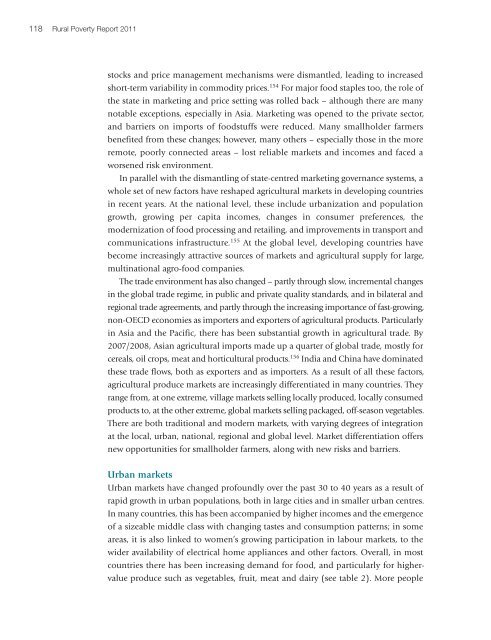English - IFAD
English - IFAD
English - IFAD
You also want an ePaper? Increase the reach of your titles
YUMPU automatically turns print PDFs into web optimized ePapers that Google loves.
118<br />
Rural Poverty Report 2011<br />
stocks and price management mechanisms were dismantled, leading to increased<br />
short-term variability in commodity prices. 154 For major food staples too, the role of<br />
the state in marketing and price setting was rolled back – although there are many<br />
notable exceptions, especially in Asia. Marketing was opened to the private sector,<br />
and barriers on imports of foodstuffs were reduced. Many smallholder farmers<br />
benefited from these changes; however, many others – especially those in the more<br />
remote, poorly connected areas – lost reliable markets and incomes and faced a<br />
worsened risk environment.<br />
In parallel with the dismantling of state-centred marketing governance systems, a<br />
whole set of new factors have reshaped agricultural markets in developing countries<br />
in recent years. At the national level, these include urbanization and population<br />
growth, growing per capita incomes, changes in consumer preferences, the<br />
modernization of food processing and retailing, and improvements in transport and<br />
communications infrastructure. 155 At the global level, developing countries have<br />
become increasingly attractive sources of markets and agricultural supply for large,<br />
multinational agro-food companies.<br />
The trade environment has also changed – partly through slow, incremental changes<br />
in the global trade regime, in public and private quality standards, and in bilateral and<br />
regional trade agreements, and partly through the increasing importance of fast-growing,<br />
non-OECD economies as importers and exporters of agricultural products. Particularly<br />
in Asia and the Pacific, there has been substantial growth in agricultural trade. By<br />
2007/2008, Asian agricultural imports made up a quarter of global trade, mostly for<br />
cereals, oil crops, meat and horticultural products. 156 India and China have dominated<br />
these trade flows, both as exporters and as importers. As a result of all these factors,<br />
agricultural produce markets are increasingly differentiated in many countries. They<br />
range from, at one extreme, village markets selling locally produced, locally consumed<br />
products to, at the other extreme, global markets selling packaged, off-season vegetables.<br />
There are both traditional and modern markets, with varying degrees of integration<br />
at the local, urban, national, regional and global level. Market differentiation offers<br />
new opportunities for smallholder farmers, along with new risks and barriers.<br />
Urban markets<br />
Urban markets have changed profoundly over the past 30 to 40 years as a result of<br />
rapid growth in urban populations, both in large cities and in smaller urban centres.<br />
In many countries, this has been accompanied by higher incomes and the emergence<br />
of a sizeable middle class with changing tastes and consumption patterns; in some<br />
areas, it is also linked to women’s growing participation in labour markets, to the<br />
wider availability of electrical home appliances and other factors. Overall, in most<br />
countries there has been increasing demand for food, and particularly for highervalue<br />
produce such as vegetables, fruit, meat and dairy (see table 2). More people

















